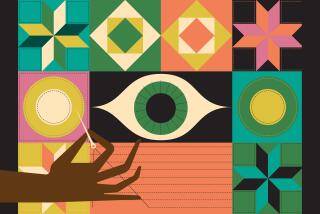DO-IT-YOURSELF : Craftspeople Learn Tricks of the Shade
Making lampshades is a likely craft to conquer for the do-it-yourselfer who has already stenciled walls, antiqued furniture and turned bedsheets into slipcovers.
“You can make a shade for less than it costs to buy one, you can get the fabrics and colors that you want, and there’s the satisfaction that you made it yourself,” says Bea Rowe of Yonkers, N.Y.
Rowe, an administrative assistant at an investment bank in New York on weekdays, learned at a weekend workshop how to make a fitted and a pleated lampshade.
“It was very good therapy after long days at work,” she reports. “There’s no great talent involved. The pleated shades anyone can make. For the fitted shades, all you have to do is pull and stretch the fabric over the frame, pin it and sew it.”
Kathleen Rath of Scarsdale, N.Y., recently made a silk shade in an adult education workshop at a local elementary school. She had made lampshades without benefit of classes when she lived in a log cabin in Oregon.
“I wanted a deer-hide lampshade, but I didn’t want to pay the prices the fancy decorator shops were asking,” she recalls.
She succeeded through trial and error and went on to make lampshades from a 1940s print tablecloth. She took the class to acquire another technique.
Scandinavians often make their own shades, says Susanne Wellott, a native of Sweden who with her partner, Cynthia Beebe, teaches lampshade-making in the New York area. Last year, Wellott and Beebe, both of Bronxville, N.Y., taught the craft at Cooper Hewitt Museum and the Pratt Institute in New York City.
A shade with fabric stretched tight over the frame is more difficult to make than a pleated shade, Beebe says.
“The fabric has to be so tight that a bead of water will bounce off, and the cutting has to be perfectly accurate,” she says. “There is less room for mistakes since any small error will show.”
The partners also teach how to make a ribbon shade, which they say is easy enough for kids to master.
A fairly large silk shade might cost $300 to $400 retail, more if it has unusual trim. But you can make your own shade for under $100. Classes by Beebe and Wellott range from about $40 to $85 per person, plus about $42 for supplies.
If you’re not up to starting from scratch, you might want to try customizing a ready-made shade, says Donna Lang of Chatham, N.J., co-author of “Decorating With Fabric” (Clarkson Potter, 1986).
Mounting photographs on a lampshade kills two birds with one stone. It dresses up the shade and is an eye-catching way to display family photos. Start with an inexpensive paper shade, plus double-faced tape or craft glue. You can glue the photos directly onto the shade, or you can slip the photos into photo corners which have been glued to the shade. Don’t use more than a 60-watt bulb with the shade, Lang says.
Another way to decorate a ready-made fabric or paper shade is to apply cut-out motifs, such as a flower pattern from excess fabric used elsewhere in the room. Iron the fabric onto adhesive-backed fusible webbing available in craft and fabric shops. Cut out the desired design and iron it onto the shade according to directions. You may need to support the lampshade with a pressing ham or rolled-up towel, Lang says.
An additional fillip is to apply a decorative trim to the top and-or bottom of the shade. Or simply dress up a lampshade by tossing a lace doily over the top. Old dresser scarves are often the right size, or you can buy a pattern and make a lace throw. Again, be careful to use a low-watt bulb.
Look for lampshade patterns in the crafts section of pattern books or catalogues from companies such as Simplicity.


